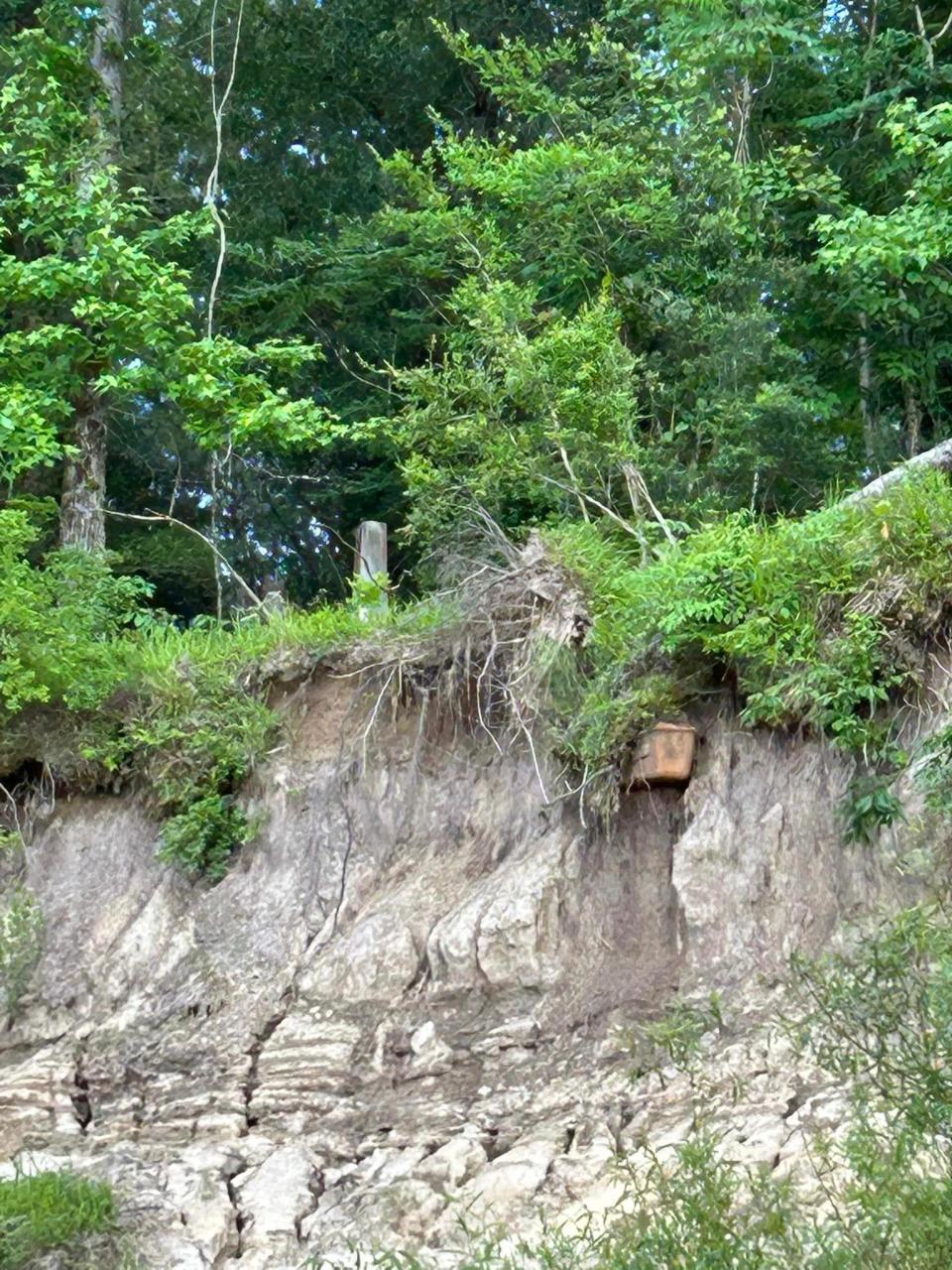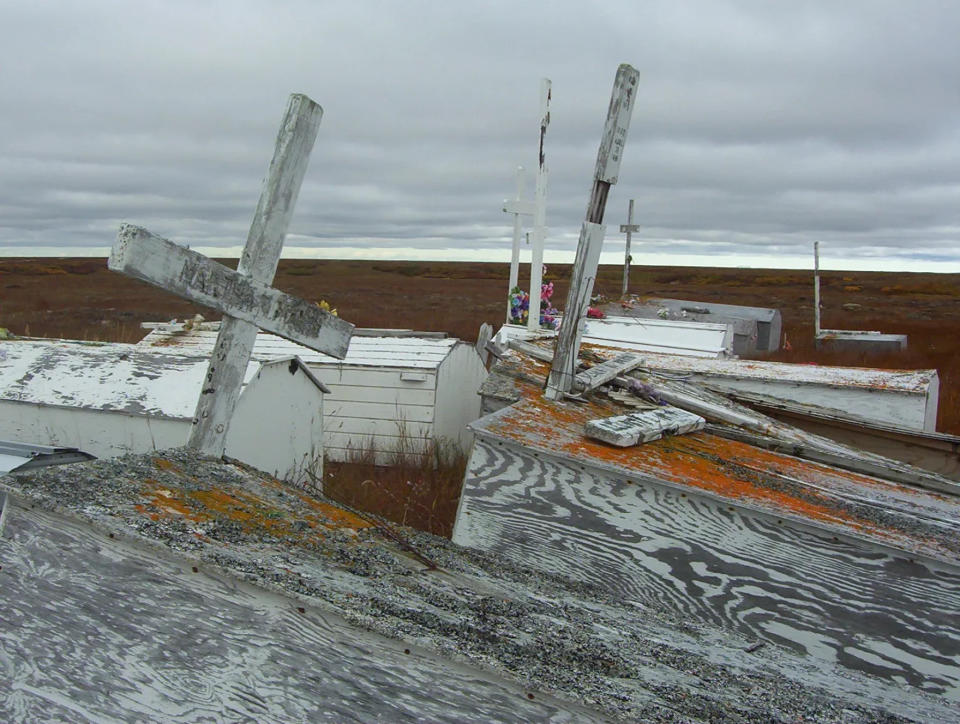When the dead don't stay buried: The grave situation at cemeteries amid climate change
Climate change isn’t just creating havoc for the living. It’s coming for our dead.
Great deluges of rain submerge graves and markers. Swift floods set vaults afloat. Slopes erode in scenic hillside cemeteries. And at the seaside, higher seas and storm surges swamp cemeteries and sweep sand away.
For Sherene Johnson’s family, it’s the rain. Ten members of her family are buried in Brighton Memorial Gardens, a predominantly African American cemetery in Brighton, Alabama.
Parts of the cemetery and the town have flooded in the past but not as often as they do today, said Johnson, a city councilwoman. The flooding routinely submerges the graves of her parents, her siblings and her siblings’ children.
The anguish it brings to her remaining family members is “traumatizing,” Johnson said.
FOR SUBSCRIBERS: Climate change is un-burying graves. It's an expensive, 'traumatic,' confounding problem.
Across the country, such heart-rending grief strikes families with increasing frequency as powerful forces rip vaults and caskets from their final resting places.

For centuries, people have buried their dead in peaceful, scenic spots meant to comfort the living and the spirits of the dead. Today many of those burial grounds rest in precarious positions, subject to rising seas and storm surge, swollen streams, wildfire and a litany of natural disasters made worse by the steady march of a warming climate.
“Wild storms and sea level rise are threatening more so than in the past,” said Leslee Keys, a historic preservation consultant based in St. Augustine, Florida.
Cemeteries have struggled with neglect, disrepair and periodic flooding, but one expert after another reports the problems are growing worse as warming temperatures fuel more extreme weather.
Orrin Pilkey has traveled the world's beaches studying coasts and barrier islands for 50 years.
“We had erosion before global climate change, but now it’s happening much more rapidly, and shorelines are eroding almost universally because of sea level rise,” said Pilkey, an author and emeritus geology professor at Duke University. “The magnitude and frequency is a heck of a lot more.”
Thousands of graves have been disturbed in cemeteries across the nation in the past 30 years. Flooding, erosion and other climate-related weather disasters have been reported in at least 21 states and 15 countries over the past three decades. Coffins have washed away and bones have been exposed in big cities and tiny hamlets.
“Trying to keep things buried that you want to stay buried is often a really big challenge,” said Allen Gontz, a professor of applied geology at Clarkson University.
State and local governments, the Federal Emergency Management Agency and cemetery associations already are spending millions to preserve cemeteries and build seawalls, and relocate or rebury remains.
“It is absolutely a problem,” said Mike Trinkley with the Chicora Foundation, a South Carolina-based group specializing in archaeological research and cemetery preservation. He estimates the cost of relocation and reburial at $8,000 to $10,000 per gravesite.
Gravestones tumble from a bluff
Judy Blair Berry and her husband were motoring along the Pearl River in Copiah County, Mississippi, in May when she looked up from the boat to see a casket jutting out of the bank above the river. Pieces of gravestones lay scattered on the shore. She snapped photos and posted them on Facebook, trying to draw attention to the troubles at historic Catchings Cemetery.

The Pearl River sees extreme swings in water levels from the control of a dam and reservoir upriver, Berry told USA TODAY. It holds back water when river flow is low, then sends a flush of water downstream when water levels rise.
“It just sucks the river banks away,” and with it trees and tombstones, she said. “No telling how many graves have already been lost to the river.”
Mississippi and its neighbors to the north are among the states in the eastern half of the United States experiencing more rainfall extremes since the 1990s, including increases in the number of days with more than an inch of rain.
From coast to coast
Rows of white crosses lean this way and that among gravesites in some cemeteries in Alaska.

Rising temperatures are thawing the permafrost into watery swamp as the ice underneath melts and loses volume, said Louise Farqurharson, a research assistant professor at the University of Alaska-Fairbanks. Sinking graves are just one of many concerns warming creates for the state's Indigenous communities.
At the opposite corner of the nation, 7.4 inches of rain in a few hours swamped parts of Bay County on Florida’s northern Gulf Coast in October 2021. As the skies cleared, Norman Forehand walked through the flooded Callaway Cemetery to check on his father.
The family had already reburied him after an earlier flood and were hoping they weren’t going to have to do it again, Forehand said. This time, everything was OK.
Callaway City Manager Ed Cook attributed the cemetery flooding in part to a massive loss of trees when Hurricane Michael made landfall in 2018. Cook said the trees had held water and helped prevent flooding.
Michael was among a relentless series of hurricanes and tropical storms that have hit the northern coast of the Gulf of Mexico.
Studies show recent extreme rainfall events such as hurricanes “are producing more intense rainfall rates and larger rainfall amounts than they would have without climate change," said Kevin Reed, associate dean for research at Stony Brook University.
DOWNPOUR A USA TODAY investigation reveals a stunning shift in the way rain falls in America.
Western states aren’t immune, either. Heat and wildfire take a toll, destroying plants and trees and leaving cemeteries susceptible to rain, erosion and mudslides.

Louisiana's floating caskets
Perhaps nowhere have the effects of climate change had more impact on cemeteries than in Louisiana.
At least 11 hurricanes have pummeled the Bayou State since 2002, disturbing thousands of graves and washing away hundreds of vaults and caskets.
A combination of subsiding land and rising oceans makes matters worse. At least a dozen cemeteries in southern Louisiana parishes have succumbed to rising seas and sinking land, The Associated Press has reported.
Water can infiltrate a burial site in several ways, and each type of casket, whether it’s sealed, unsealed or inside a vault, can develop issues. For example:
Wooden caskets can decompose and spring leaks.
Air pockets trapped inside above-ground vaults make them more likely to float.
Metal caskets, sometimes called self-sealers, have rubber gaskets, and when funeral homes close them, it creates an airtight compartment – and buoyancy.
If soils get saturated, or if there’s enough water for a long period of time, caskets will float.
“Anything that’s airtight and can develop buoyancy has the potential of resurfacing," Trinkley said. When water fills a grave, whether below ground or in an above-ground vault, that casket “is going to float just like a battleship.”
And they will float as far and as high as the floodwaters take them, he said. They're sometimes found in tree tops when the water recedes.
Lora Ann Chaisson, principal chief of the United Houma Nation, Louisiana's largest Native American tribe, first remembers seeing caskets piled up after popping out of the ground during Hurricane Juan in 1985 in Grand Caillou, Louisiana. Grim scenes that unfolded in the days ahead are etched into her memory.
“Just to see that and to experience that, and have to go through reburying all those folks there, that was horrible,” Chaisson said. “That still bothers me.
“The saddest thing after a hurricane is not losing your home or anything. It’s having to rebury your loved ones.“
Cultural connections
Historic African American cemeteries and the burial grounds of Indigenous people are often more at risk than others, and those risks are increasing, said Jennifer Blanks, a doctoral candidate at Texas A & M University who studies cemeteries.
The graves and cemeteries may be forgotten on private land, inaccessible or established historically in low-lying locations on land no one else wanted, said Andrea Roberts, an associate professor at the University of Virginia and co-director of its Center for Cultural Landscapes.
Trying to sort out ownership and who’s responsible is often difficult and makes protecting cemeteries even more complex, Roberts said. Sometimes, those who serve as caretakers have no legal documentation or proof of ownership. It can be challenging to find the cemeteries, get access and then make sure others can find them on a map.
But these cemeteries are important to the cultural history of communities, telling yet-to-be written stories about the lives of the people who lived and died there, Blanks said. History that can be pieced together from gravesites can be crucial to establishing a community’s history or sense of place.
“Cemeteries are often the only way we’re able to establish a historic Black settlement ever existed,” Roberts said. But in Texas, she said, climate change threatens to obliterate cemeteries that are the last remnants of unmarked, historic Black communities.
Eternal rest? Traumatic choices.
The scale of the problem confronting cemeteries is "immense,” said David Anderson, professor in the anthropology department at the University of Tennessee. “It affects everybody, across the world.”
Graves have been lost, flooded or disrupted by rain and storms in at least five countries over the past year, including Nigeria, Thailand and the United Kingdom.
“Probably every cemetery that’s within a few feet of being flooded is going to be a major challenge,” Anderson said. "Some of them are going to be lost.”
For one of the Houma nation’s tribal burial grounds, the elders preferred to leave the dead at rest and undisturbed by allowing the graves to be permanently submerged, Chaisson said. But, she added, "that should never be a decision people have to make."
Addressing the future of cemeteries will require support from the public and politicians, and a move beyond traditional thinking, Anderson said.
Options are available to help protect cemeteries and have been used at some locations in the U.S., including adding seawalls and stabilizing shorelines.
A more complex and expensive step also has been needed in some cemeteries: moving the graves to safer locations.
Trinkley estimates the archaeological cost of recovering remains at about $3,000 a grave, not including the cost of the new burial location or casket.
Depending on circumstances and local rules, total costs can rise to $8,000 to $10,000, he said. “When you start looking at the number of dead people on the coast that are susceptible to this issue, the number starts looking astronomical fairly quickly."
Last year, when Johnson took flowers out to the Brighton cemetery to commemorate her sister's birthday, she noticed several of her family members' headstones had been dislodged by flooding. She paid someone about $75 a grave to reset the stones in concrete, again.
She is determined to push her fellow city council members to address the flooding citywide, which she hopes will help the cemetery reduce its flooding, and prepare for future rainfall.
It’s hard to call her nephew and other family members to tell them the headstones have to be fixed again, she said. “You have to carry that weight, or struggle with that to get it right. Yes, it’s overwhelming for me, but I’d rather carry it than allow them to carry it.”
This article originally appeared on USA TODAY: Climate change effects in cemeteries: Floating caskets, missing bodies

